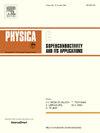Research on the HTS joint for 10kA-level CORC cable with forced-flow cooling
IF 1
3区 物理与天体物理
Q4 PHYSICS, APPLIED
Physica C-superconductivity and Its Applications
Pub Date : 2025-05-01
DOI:10.1016/j.physc.2025.1354731
引用次数: 0
Abstract
Due to the high critical current and excellent flexibility in winding, Conductor on Round Core (CORC) cable had become one of the most ideal basic units for constructing high-temperature superconducting (HTS) coils. Under conditions of rapid current and magnetic field variations, the cables experience hysteresis losses in ReBCO tapes and eddy current losses in the copper tubes. Forced-flow cooling method could remove heat in time, thereby maintaining the temperature of the tapes. So for large-scale scientific devices such as magnet system of the accelerators, forced-flow inside the tubes has become the most efficient cooling method. However, in the manufacture of HTS magnets, it is common practice to solder the ends of the cables to copper blocks to prepare joints. This method is only suitable for immersion or conduction cooling. Therefore, the development of an HTS joint capable of meeting the forced-flow cooling requirements of the CORC cable becomes essential. This article proposes a novel HTS joint design, which can realize double-channel forced flow cooling for CORC cable. The ReBCO tapes can be directly in contact with liquid helium. The joint resistance at 4.5 K is 25.3 nΩ. Through thermal-hydraulic analysis, with the implementation of the joint designed in this article, at 3.5 T, the minimum quench energy (MQE) of double-channel forced-flow cooling cable is 220.12 J for long disturbance, significantly higher than that of single-channel forced-flow cooling cable. These results demonstrate that the joint developed in this article markedly improves the operational stability of the CORC cable.
10ka级强流冷却CORC电缆HTS接头的研究
圆芯电缆由于具有较高的临界电流和良好的绕线柔韧性,已成为构建高温超导线圈最理想的基本单元之一。在电流和磁场快速变化的条件下,电缆在ReBCO带中出现磁滞损耗,在铜管中出现涡流损耗。强制流动冷却法可以及时散热,从而保持胶带的温度。因此,对于大型科学装置,如磁体加速器系统,管内强制流冷却已成为最有效的冷却方法。然而,在高温超导磁体的制造中,通常的做法是将电缆的末端焊接到铜块上以准备接头。这种方法只适用于浸没冷却或传导冷却。因此,开发一种能够满足CORC电缆强制流动冷却要求的高温超导接头变得至关重要。本文提出了一种新型的高温超导接头设计方案,该方案可实现CORC电缆的双通道强制冷却。ReBCO胶带可以直接与液氦接触。在4.5 K处接头电阻为25.3 nΩ。通过热液分析,在实现本文设计的接头时,在3.5 T时,双通道强制冷却电缆长扰动的最小淬火能量(MQE)为220.12 J,明显高于单通道强制冷却电缆。结果表明,本文所研制的节理可显著提高CORC索的运行稳定性。
本文章由计算机程序翻译,如有差异,请以英文原文为准。
求助全文
约1分钟内获得全文
求助全文
来源期刊
CiteScore
2.70
自引率
11.80%
发文量
102
审稿时长
66 days
期刊介绍:
Physica C (Superconductivity and its Applications) publishes peer-reviewed papers on novel developments in the field of superconductivity. Topics include discovery of new superconducting materials and elucidation of their mechanisms, physics of vortex matter, enhancement of critical properties of superconductors, identification of novel properties and processing methods that improve their performance and promote new routes to applications of superconductivity.
The main goal of the journal is to publish:
1. Papers that substantially increase the understanding of the fundamental aspects and mechanisms of superconductivity and vortex matter through theoretical and experimental methods.
2. Papers that report on novel physical properties and processing of materials that substantially enhance their critical performance.
3. Papers that promote new or improved routes to applications of superconductivity and/or superconducting materials, and proof-of-concept novel proto-type superconducting devices.
The editors of the journal will select papers that are well written and based on thorough research that provide truly novel insights.

 求助内容:
求助内容: 应助结果提醒方式:
应助结果提醒方式:


